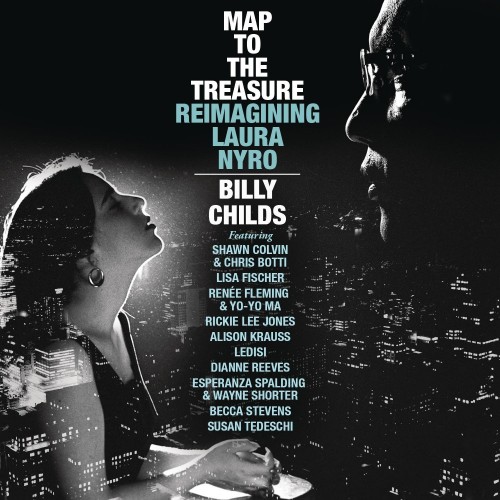Music Preview: Billy Childs Reimagines Laura Nyro
By Evelyn Rosenthal
Childs’s aim was to reimagine Nyro’s music. “I took what the songs meant to me and heightened that, illustrated it more, through the lens of my experience.”
Billy Childs’ Map to the Treasure: Reimagining Laura Nyro, featuring Becca Stevens, Alicia Olatuja, and the Parker Quartet
Presented by Celebrity Series of Boston
Friday, January 22, 8 p.m.
Sanders Theatre, Cambridge, MA
When pianist/arranger/composer Billy Childs was around 12 or 13, his older sister turned him on to one of her musical passions—the uniquely gifted singer-songwriter Laura Nyro. In a career that kicked into gear with her first album, More Than a New Discovery (1966), and lasted more or less until her death at age 49 from ovarian cancer in 1997, Nyro wrote songs that became hits for many other artists and recorded numerous critically acclaimed albums. Mainstream audiences were more familiar with the covers—the Fifth Dimension’s versions of “Stoned Soul Picnic” and “Wedding Bell Blues,” Blood, Sweat, and Tears’s take on “And When I Die,” Barbra Streisand’s “Stoney End.” But Laura Nyro also influenced and inspired many of her fellow musicians and had a devoted following, especially among women who, like Childs’s sister—and me—were in their late teens when her late-’60s masterpieces Eli and the Thirteenth Confession and New York Tendaberry came out. While I walked the halls of my high school singing Nyro’s songs, Billy Childs was becoming immersed in the world and sounds of her music that would eventually lead him to create the stunning album Map to the Treasure: Reimagining Laura Nyro. On Friday, January 22, Celebrity Series of Boston will present the concert version of the project at Sanders Theatre.
Released in 2014 and nominated for three 2015 Grammys (it won for Best Arrangement, Vocals and Instruments, for the song “New York Tendaberry”), the recording features 10 Nyro compositions, each sung by a different vocalist. Childs’s rich, complex arrangements and orchestrations include a string quartet, harp, and various horn players, in addition to his piano and a rhythm section. As a longtime presence in both jazz and classical music and a Grammy perennial (13 nominations, 4 awards), Childs had no trouble attracting top talent to the project from the many musical genres Nyro’s work encompasses: singers Renée Fleming, Dianne Reeves, Esperanza Spalding, Alison Krauss, Shawn Colvin, Lisa Fischer, Ledisi, Rickie Lee Jones, Susan Tedeschi, and Becca Stevens, along with Yo-Yo Ma, Wayne Shorter, Chris Potter, Chris Botti, Steve Wilson, and Jerry Douglas.
The project, Childs told me in a recent interview, gestated for 12 years, taking different forms, starting with an all-instrumental version, which he ditched upon realizing how integral the lyrics were to Nyro’s music. Then, he said, “I thought maybe I’d get a really good singer, but what would happen would be that singer would be compared to Laura. And so I said, it will just have to be multiple singers.” With that decision, he naturally turned to his old friend Larry Klein to produce. Not only had Klein produced albums for many female singer-songwriters, from Joni Mitchell and Shawn Colvin to Luciana Souza, Madeline Peyroux, and Melody Gardot, but he also produced Herbie Hancock’s Grammy-winning tribute to Mitchell, River: The Joni Letters. He and Childs met during their high school years in Los Angeles at a music program in the USC Community Schools. When Klein, a jazz bass player, started playing with Freddie Hubbard, he got Childs on the gig, too. “We played together with Freddie for about four or five years. And we developed together. I would spend the night at his house, and we’d try to be Bill Evans and Eddie Gomez, and we’d try to be Herbie Hancock and Ron Carter.”
Childs was surprised, he said, that no jazz artist had yet done a full-on tribute to Nyro. In addition to her powerful music, what had grabbed him as a kid was her theatricality and storytelling. “Especially the first four albums always reminded me of a long play or an opera. Each song was like a chapter, and she’d have these recurring characters—God, the devil, her parents, her errant lovers, the people she would see on the street. All of these characters would recur, so it gave you the impression of continuity—it was like a story that was told. The lyrics kind of guided me into a head space; they didn’t really tell you literally what the story was—you used your imagination and your mind to fill in the blanks.”
Make no mistake—this is not a collection of straight covers or greatest hits. Only two of the songs made famous by other artists are included, “Stoned Soul Picnic” (sung by R&B singer Ledisi) and “And When I Die” (sung by bluegrass-country superstar Alison Krauss). Childs’s instinct was to delve into Nyro’s book and pull out the songs he loved and find some obscure gems. “There were three songs that just simply had to be on the album. And those were ‘Map to the Treasure,’ ‘New York Tendaberry,’ and ‘Gibsom Street’; those three conjured up in my mind images that suggested very strongly how they should be approached. And ‘Map to the Treasure,’ the piano pattern on there was one of the first piano patterns that I ever learned, so it really had to be on there. ‘The Confession’ was another one that was pretty essential.”
Childs’s aim—as the album’s subtitle says—was to reimagine Nyro’s music: “I took what the songs meant to me and heightened that, illustrated it more, through the lens of my experience . . . which includes Laura Nyro, but also Herbie Hancock, Emerson, Lake & Palmer, all sorts of different influences.” Klein was intimately involved, contributing “really great ideas orchestrationally and musically and creatively.” The most radically reimagined song on the album, sung by Shawn Colvin, is “Save the Country,” Nyro’s upbeat, gospel-tinged call for peace and civil rights. While the original bounces along to the beat of a tambourine, Childs slows it down and, with strings and a plaintive trumpet (played by Chris Botti), it takes on a hymnlike quality. “I wanted to do it more like Laura did it,” Childs said. “She had kind of this optimism; still, it’s basically ‘Save the country while we still can, let’s band together.’ And Larry suggested that maybe we should approach it from the vantage point of today, where we’re still going through the same shit, and we have Donald Trump. The horrible thing about Donald Trump is not Donald Trump, but what he has exposed about America. So when you look at it that way, it’s more from a sense of resignation or realism.”
Klein was not the only one whose suggestions helped shape the album. For “And When I Die,” Childs had planned to have Alison Krauss also play violin. Instead, she suggested calling in her friend and longtime collaborator Jerry Douglas to play dobro on the tune. She also brought in another of her regular band members, Dan Tyminski, who joined her to sing on the extended outro chorus that, Childs said, was also her idea. Giving opera star Renée Fleming her choice of songs, he was thrilled when she chose “New York Tendaberry,” a tender (yes), impressionistic ode to Nyro’s native city, because he had already imagined “a conversation between piano, voice, and cello” as the track’s centerpiece, and Fleming would fit nicely with another classical star, Yo-Yo Ma.
For the tour, Childs needed singers who could do justice to all the songs. He didn’t have to look far to find Becca Stevens, whose own music is a hard-to-categorize mix of jazz, folk, and indie-rock, because she gave a thrilling performance of “The Confession” on the album. And after listening to Alicia Olatuja on the advice of their mutual agent, he was sold. The classically trained singer is equally at home in jazz, R&B, musical theater, and gospel (she won raves as the soloist with the Brooklyn Tabernacle Choir on the “Battle Hymn of the Republic” at the second Obama inauguration). “They’re friends of mine, and they bring this joy, this effervescence to the music,” Childs said. “They’re both incredibly experienced and really musical singers, but they also have a youth that kind of is wide open for the music to go in any direction.”
In fact, Stevens and Olatuja, both in their early thirties, had never listened to Laura Nyro before Childs’s project. In a recent interview, Stevens told me that, although she hadn’t gotten around to it before, she had been meaning to listen to Nyro because “There were a couple of people who came up to me after shows and said, ‘I can hear the influence of Laura Nyro in your music,’ and I would say ‘I’ve heard that name, but I’ve never listened to her music.’” Once she finally did, her reaction was, “I definitely should have checked this out sooner, because she’s a force of nature, and she’s clearly the influence of people that I’m listening to. And her storytelling is something that I’ve learned so much from in working on her music with Billy.” Olatuja was equally impressed by Nyro: “I pretty much binged on her work after I got called for this,” she told me in an interview. “And I just thought, Wow, this woman, she was way ahead of her time. She was kind of like this soulful chameleon, too, with her musical approach, and so many diverse artists enjoyed singing her work and working with her because she just had such an incredible musical vocabulary.”
Both women identify with Nyro’s genre-bending approach, which draws on jazz, soul, gospel, pop, Broadway, opera, and doo-wop. “I think that’s why Billy felt like he needed to hire so many different singers for the project,” Stevens said, “because Laura Nyro is kind of like a shapeshifter . . . she’s got so many different flavors.” And for Olatuja, whose influences range from Take 6 to Whitney Houston to Leontyne Price,
“not confining your sound to a certain category or genre bubble just opens up more opportunities to reach people who maybe aren’t even considering themselves to be jazz lovers, or whatever genre they have told themselves they don’t like. You get an opportunity to just say, ‘This is music,’ and music speaks to the human experience, so just listen, . . . see if you can feel connected to it and go from there, and open yourself up to that experience. I think having that kind of mindset is one of the commonalities between artists like myself and Becca, and definitely Laura Nyro.”
In the concert, Stevens and Olatuja will split the album’s songs. Stevens, of course, will reprise her version of “The Confession.” She had this to say about the meaning of that quintessential Nyro song from Eli and the Thirteenth Confession, and her experience singing it:
“I think of her talking about the experience of falling in love for the first time, in a way that you never have before, that awakens you emotionally and sexually, and it makes you feel as though you’re losing your virginity. . . . I felt like it pushed me beyond anything I’ve ever done before. . . . Also, it’s just perfect for my voice. It sits in this register that has frailty and vulnerability, but also it’s a register where I can hold out long notes and make them really intense and full. . . . It’s a super-intense lyric, and every time I sing that song, even when I’m singing four other songs on a set with Billy, that one feels so me, and I feel this really intense, exciting energy coming up through my feet.”
Olatuja’s favorite is another love song, “Map to the Treasure,” but she also has the challenge of singing two of the darkest tunes on the album. “Gibsom Street” is a place so dismal “they hang the alley cats,” and “Been on a Train” tells the stark story of a junkie’s overdose death. While her own music includes more upbeat, joyful fare (see her excellent 2014 debut album Timeless and its release concert, available for viewing on her website), to connect to Nyro’s lyrics, Olatuja draws on her experience years ago with a boyfriend who struggled with drug abuse. She has also taken a lesson from Nyro’s forthrightness. “She has a fearlessness about being as vulnerable as she is in the moment of writing. A lot of times we want to release something or share a piece of music that shows us in a particular light that’s all about us being fabulous, or all about us being strong, but sometimes when you’re in a broken situation you want to sing about those experiences and connect them, because the audience that’s taking the music in is going to be filled with a variety of individuals at different places in their lives.” Olatuja credits Nyro’s example for giving her permission to “surrender to certain vulnerabilities” in her own life as she works on songs for her second album.
Stevens’s two most recent albums, the stellar Perfect Animal (2014) and Weightless (2011), contain a few well-chosen and satisfyingly reworked covers, and she has also recorded and toured with Travis Sullivan’s Björkestra, another project dedicated to a highly original female singer and composer. About covering other artists’ songs Stevens said, “I find inspiration in the challenge of tapping into the integrity of the original, but then approaching it in a way that is like an honest Becca expression. So people who hear it, who might recognize the original song, will get a sense of who I am through their own window of familiarity.” With Björk’s music, Stevens stressed her desire to honor “the integrity of what she does without trying to mimic it in any way.”
She took the same approach to singing Nyro: “When I was learning ‘The Confession’ I would go back and forth between Billy’s demo that he made for me and then Laura’s recordings. I wouldn’t allow myself to listen to one of them more than once without going to the other because I wanted to make sure I wasn’t singing it too much like Laura, or forgetting who she was. And I did that with all the songs that he asked me to learn. I made sure to listen to her version as much as I sang it in my own way, to use that as an anchor, but not mimic it too much.”
In addition to the two singers, Childs invited the Parker Quartet, currently in residence at Harvard, to take up string duties at Sanders (and the tour’s stops in Vermont and New York). Filling out the band will be the harpist from the recording, Carol Robbins; Peter Sprague on guitar; Ben Williams on bass; Billy Kilson on drums; and Bob Sheppard on sax and flute.
Both the Celebrity Series concert and the recording offer Nyro fans a chance to rediscover the songs in new interpretations. Most commenters on Amazon and other websites, Childs said, “are appreciative of someone even doing Laura Nyro and bringing her to the awareness of people who might not have heard of her. . . . They look beyond whether they like the music or not, but they usually really love the music. To them it means that Laura Nyro is being honored the way that she should be.” For Alicia Olatuja, what comes through clearly is the versatility and power of Nyro’s writing. “Quality writing is like a beautifully made garment. Worn on different bodies it shows different curves, different ways of being worn, but it still remains a beautiful garment. That’s how I feel with this music; I’m honored to be a part of it.”
Evelyn Rosenthal is the former editor in chief and head of publications at the Harvard Art Museums. She is also a professional singer, specializing in jazz and Brazilian music. She writes about musical theater, music, and books for the Arts Fuse.
Tagged: Alicia Olatuja, Becca Stevens, Billy Childs, Laura Nyro





